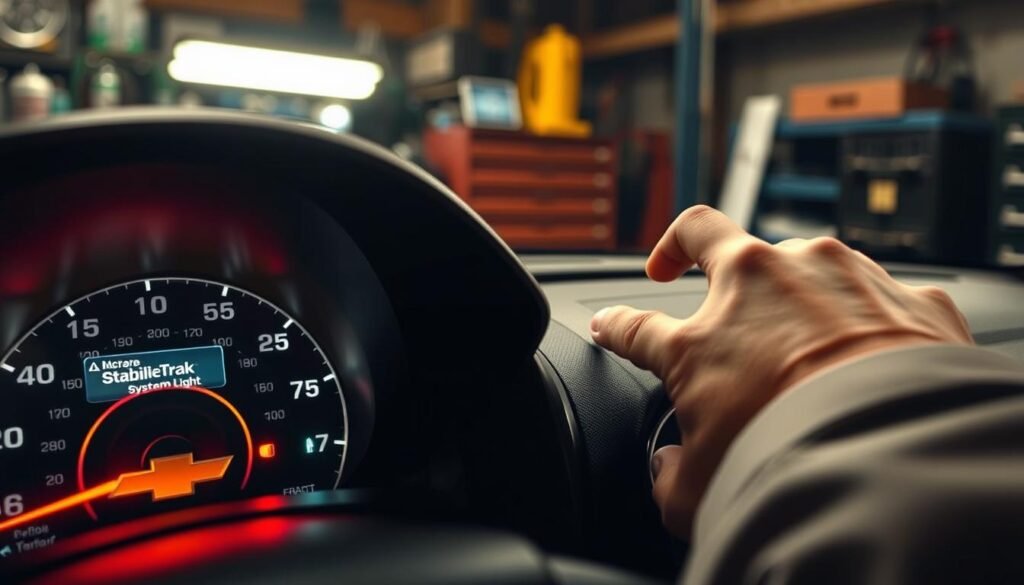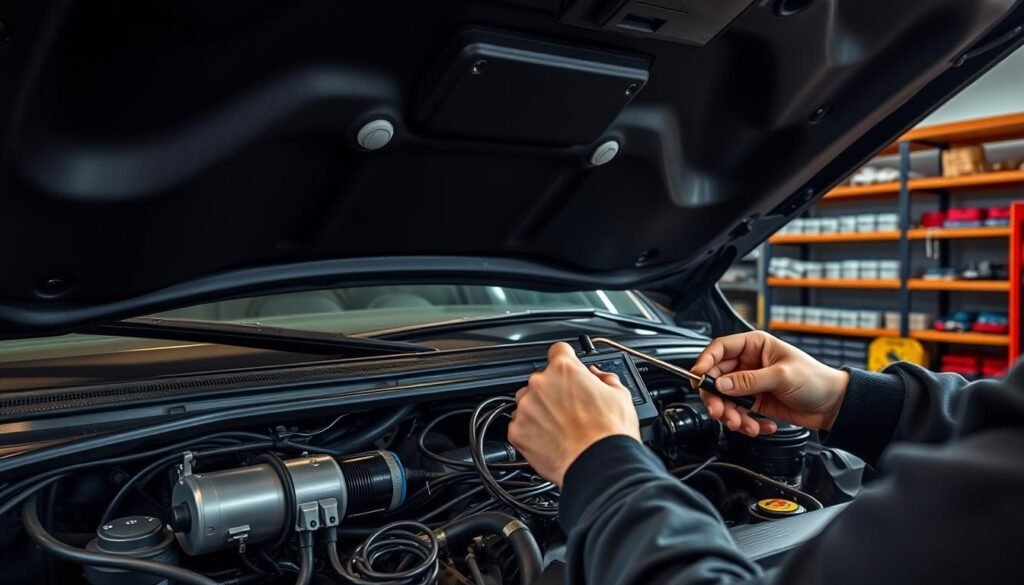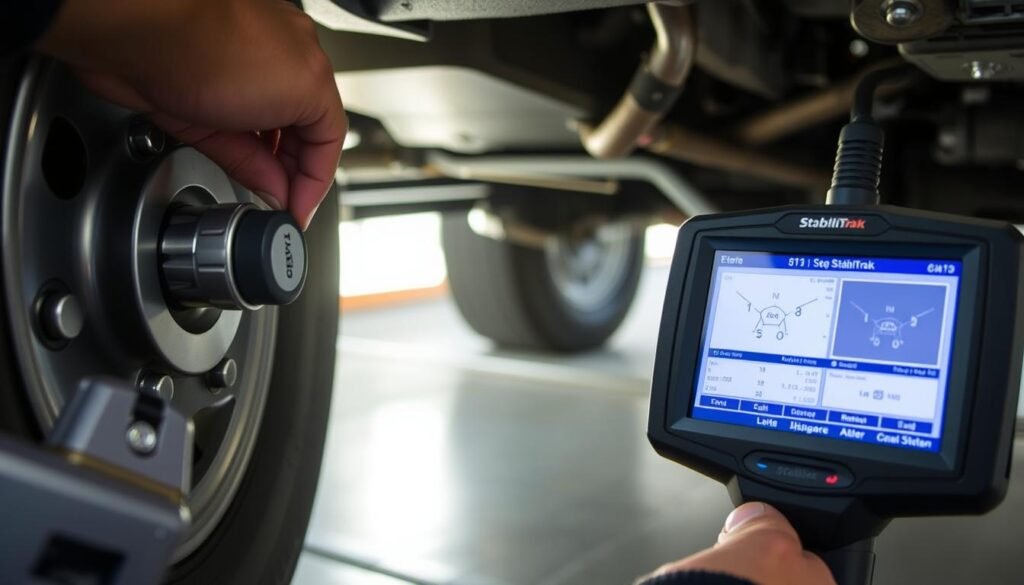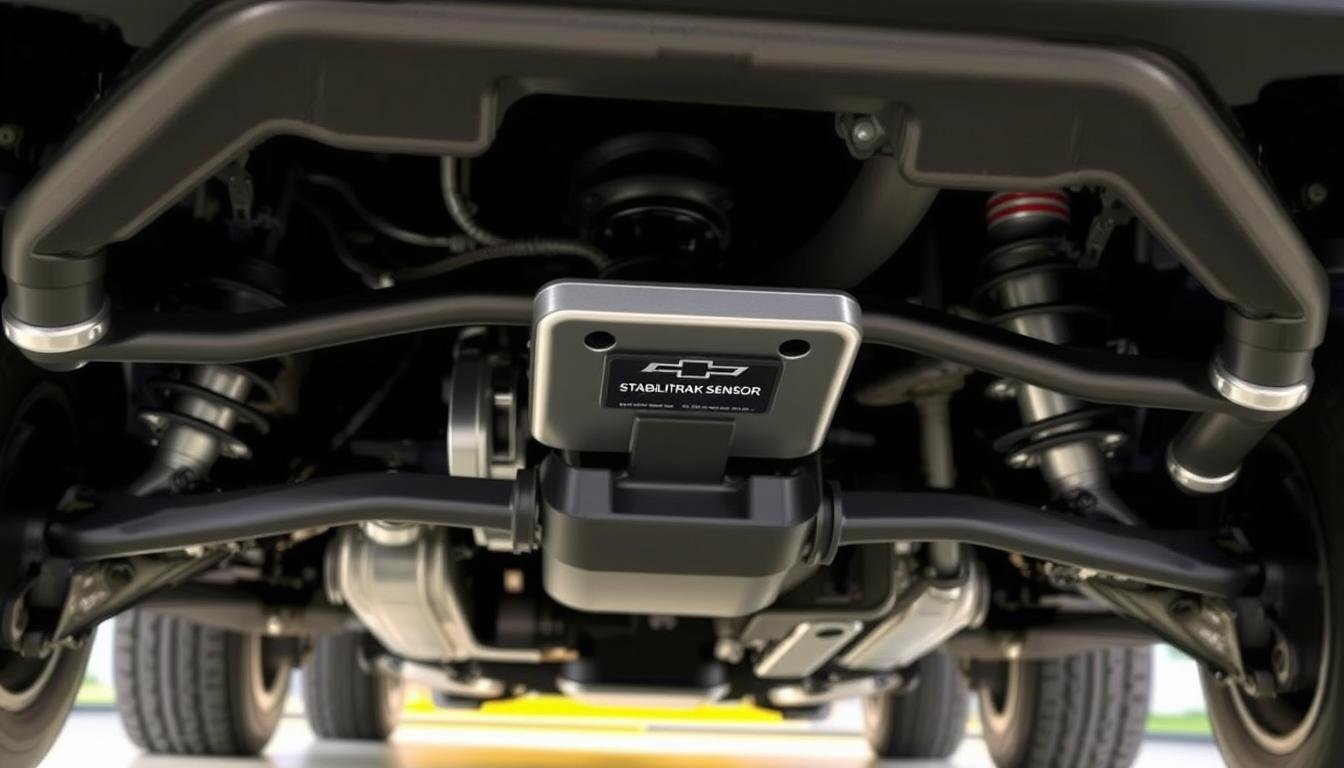Chevy StabiliTrak Sensor Location Guide & Tips
Knowing where the Chevy StabiliTrak sensor is placed is key for your vehicle’s safety. This guide will show you where to find important sensors in the Chevy StabiliTrak system.
It helps stop traction loss and steering problems. It’s important to know about these parts to fix any StabiliTrak issues, like when the warning light comes on.
We will explain the StabiliTrak system’s main parts, common signs of problems, and how to troubleshoot.
You will find out how to reset the system yourself or when to use diagnostic tools for harder issues.
Keeping up with Chevy StabiliTrak sensor locations and regular maintenance will make your vehicle run better and safer.
What is The Chevy StabiliTrak System?
The Chevy StabiliTrak system is a high-tech way to keep your car safe. It always checks how the car moves and makes fast changes to the brakes and engine power.
This helps your car stay steady, especially in bad weather or when turning sharply. This system is key to stopping slides and keeping control on slippery or bumpy roads.
It quickly works to fix traction problems, making your ride smoother and safer. Knowing how it works shows you its value for your car’s performance and safety.
Key Components of The StabiliTrak System
The StabiliTrak system keeps vehicles safe. It uses sensors and control modules to improve stability when you drive.
Knowing about these parts can help you understand how your car works better. One important part is the wheel speed sensors.
These keep track of how fast each wheel is spinning. They send this data to the system for better control over the car’s traction.
If a wheel starts to slip, the system adjusts the power to fix it. The steering angle sensor is also crucial. It checks where the steering wheel is pointing.
This lets the StabiliTrak system help steer the car the way you want, making turns smoother. Another part is the yaw rate sensor. It looks at how the car is rotating.
If the car rotates too fast or starts to skid, the sensor helps correct it. This keeps the car stable on the road. Finally, the Electronic Control Unit (ECU) brings everything together.
It takes data from the chevrolet stabilitrak sensor and other parts. Then, it quickly makes changes to help keep the car steady. This makes your rides smoother and safer.
| Component | Function |
|---|---|
| Wheel Speed Sensors | Monitor wheel rotation speed and adjust power to maintain traction. |
| Steering Angle Sensor | Tracks steering wheel position to enhance vehicle responsiveness. |
| Yaw Rate Sensor | Measures rotational movement to ensure stability during turns. |
| Electronic Control Unit (ECU) | Analyzes sensor data to implement stability adjustments in real-time. |
Chevy StabiliTrak Sensor Location
Knowing where the sensors in your Chevy are can really help with upkeep and fixing problems.
Compromise where these chevy stabilitrak sensors are makes it easier to diagnose and fix issues. Here, you’ll find important info about the StabiliTrak system’s parts.
Wheel Speed Sensors
Wheel speed sensors, also known as ABS sensors, track how fast each wheel spins. In Chevrolets, these are near each wheel hub, close to the brakes.
The back wheel’s sensor is on the wheel cylinder or rear axle. Where these sensors are can change based on the ABS type.
A four-sensor ABS has one at every wheel. But, a three-sensor system has them on the front wheels and one on the back axle.
Steering Angle Sensor
The steering angle sensor (SAS) is key for the stability control system. It checks the angle and turn rate of the steering wheel. In Chevys, it’s in the steering column, near the wheel.
This spot is perfect for accurately tracking your steering moves. It makes sure the right data goes to the car’s computer for better stability control.
Yaw Rate Sensor
The yaw rate sensor keeps the car stable when turning. It’s usually on the Chevy’s chassis, close to the middle of the car. It senses how much the car rotates vertically, giving vital info to the stability system.
This helps make quick stability adjustments during different driving situations. Knowing where the yaw rate sensor is is key for looking after your car.
Signs of StabiliTrak System Failure
Knowing the signs of StabiliTrak failure is key to keep safe and your vehicle running well. If ignored, it could lead to less control or even crashes.
Here are a few signs that show the StabiliTrak system might need a check-up.
StabiliTrak Warning Light Activation
The StabiliTrak warning light on your dashboard means something’s not right. This light could stay on, telling you that the system is trying to fix a problem or needs immediate help because of issues with sensors, control modules, or brakes.
It’s very important to deal with this warning light fast to ensure your vehicle is safe.
Loss of Traction Control
If StabiliTrak isn’t working right, you might lose traction. This increases your chance of sliding, especially on slick roads.
You may notice it’s hard to keep your car steady, it skids more, or it accelerates slower than usual. These signs of losing grip need quick action to avoid risky driving situations.
Vehicle Handling Changes
StabiliTrak problems can also change how your vehicle drives. You might feel it’s harder to steer or it doesn’t accelerate smoothly.
If you hear odd noises like grinding or whirring from the brakes, or if it’s tough to change gears, these are warnings.
They show there might be problems that you shouldn’t wait to check out.

Basic Troubleshooting For StabiliTrak Issues
Trying simple fixes can often solve StabiliTrak problems. Knowing what signs to look for in your car can greatly help in fixing issues quickly.
Checking For Warning Lights
When troubleshooting, first look at the dashboard for warning lights. A lit StabiliTrak warning light can show different problems that need to be looked at.
Inspecting Battery Connections
Check if the battery and its connections are tight and clean. Since electrical problems can impact how sensors work, checking the battery is key for StabiliTrak maintenance.
How To Reset The StabiliTrak System?
To fix minor problems, resetting the StabiliTrak system helps. You can manually reset it or use diagnostic tools. Each method works best in different situations.
Manual Reset Procedures
Follow these simple steps for a manual reset:
- Turn off the engine completely.
- Disconnect the battery. Wait at least five minutes.
- Reconnect the battery securely.
- Start the vehicle and see if the StabiliTrak resets.
Using Diagnostic Tools
If manual reset doesn’t work, diagnostic tools offer a deeper fix. An OBD-II scanner is useful here:
- Plug the OBD-II scanner into the vehicle’s diagnostic port.
- Pick the option to read StabiliTrak related codes.
- Reset the system and clear any errors following the screen prompts.
Using diagnostic tools not only resets the system but can also find and fix deeper issues.

| Method | Procedure | Ideal Usage |
|---|---|---|
| Manual Reset | Turn off engine, disconnect battery, reconnect, restart. | For simple, quick fixes. |
| Using Diagnostic Tools | Connect OBD-II scanner, read and clear codes. | For solving complex problems with detailed diagnostics. |
Common Problems with The Chevy StabiliTrak System
The Chevy StabiliTrak system keeps your car stable and safe. Sometimes, it can have problems that affect how it works. Knowing these issues helps you catch them early.
Sensor Malfunctions
Sensors in the StabiliTrak system often fail. These include wheel speed, steering angle, and yaw rate sensors.
They are key for the system to work right. If they stop working, you might see warning lights or your car might act weird.
Here are common signs:
- StabiliTrak warning light illumination
- Inconsistent traction control
- Unexpected changes in vehicle handling
Electrical System Issues
StabiliTrak can also have electrical problems. This includes issues like bad wiring or poor battery connections.
These can mess up how sensors read, hurting the system’s effectiveness. Look out for these signs:
- Intermittent operation of the StabiliTrak system
- Warning lights that appear and disappear
- Difficulty in starting the vehicle
| Problem Type | Possible Symptoms | Implications |
|---|---|---|
| Sensor Malfunctions | Warning lights on dashboard, loss of traction control | Reduced stability and control while driving |
| Electrical Issues | Intermittent warnings, slow starts, erratic system behavior | Potential failure to engage safety features |
Maintaining Your Chevy StabiliTrak System
Keeping the StabiliTrak system working well is very important. By doing routine checks, you can catch problems early. This makes sure the system is safe and reliable.
Routine Inspections
Here are some key things to do to keep your StabiliTrak in great shape:
- Regular Brake System Inspections: The brake system is very important for StabiliTrak. Check the brake pads, rotors, fluid levels, and look for leaks.
- Wheel Speed Sensor Maintenance: Keep wheel speed sensors clean for accurate readings. Wash off dirt and use special cleaners for a deeper clean.
- Tire Maintenance: Check that tires are filled right and rotate them often. This helps tires wear evenly and improves StabiliTrak performance.
Software Updates
It’s crucial to keep your car’s software up-to-date for StabiliTrak to work best. Car makers put out updates to make it respond better and fix issues.
Always check with your car’s maker or a pro to keep software updates fresh. This boosts how well the system works a lot.

How To Fix StabiliTrak Warning Light Issues?
Fixing the StabiliTrak warning light improves your vehicle’s safety and driving smoothness.
Knowing the different warning light patterns helps spot problems. Each pattern tells you something specific, guiding you in fixing the StabiliTrak issues.
Interpreting Warning Light Patterns
To start fixing the StabiliTrak warning lights, notice if the light stays on or blinks:
- Solid Light: This means there might be a problem that needs checking but it’s not an emergency. Look at the sensors and other parts.
- Flashing Light: This points to a serious issue that needs quick attention. You’ll need to do more checks.
Steps For Troubleshooting Warning Lights
To fix the problem correctly, follow these steps:
- Use an OBD-II scanner to get trouble codes from your car’s system.
- Look at the codes to figure out which sensors might not be working right.
- Check those sensors for any physical damage or if they’re not plugged in properly.
- Look for any damaged wires or connectors.
- After fixing the issue, clear the warning light with the OBD-II scanner.
Preventive Measures For StabiliTrak Problems
It’s crucial to take steps to keep StabiliTrak working well over time. Paying attention to how you maintain your vehicle and your driving habits can make a big difference.
It helps StabiliTrak work better and keeps your vehicle safe.
Regular Maintenance Tips
To make sure your StabiliTrak system works as it should, keep up with certain maintenance tips.
Focus on these important practices:
- Regular Tire Pressure Checks: Keeping the right tire pressure helps your vehicle stay stable and under control. If tires are not properly inflated, they can cause more resistance on the road and use more fuel. The National Highway Traffic Safety Administration (NHTSA) reports that tires not inflated enough can lower fuel efficiency by up to 3%. So, checking tire pressure often is key for helping StabiliTrak.
- Proper Tread Depth Maintenance: Having enough tread on your tires prevents sliding on wet roads and improves road grip. The Rubber Manufacturers Association warns that not enough tread can raise your chances of accidents. Keep your tread depth at least 2/32 of an inch to ensure your car performs well.
- Tire Rotation: Rotating your tires regularly helps them wear evenly and last longer. The Tire Industry Association suggests doing this every 5,000 to 7,500 miles. It keeps the wear balanced and helps StabiliTrak work better.
Driving Techniques For Stability
Using the right driving techniques is also key for keeping your vehicle stable. Try these strategies:
- Smooth Steering and Braking: Sudden turns or stops can make your car lose grip, especially on slick roads. Moving slowly helps keep the tires on the road and stops StabiliTrak from turning on when it doesn’t need to.
- Traction Control Systems (TCS): New cars often have a traction control system. It adjusts the power going to the wheels and applies brakes to avoid losing grip. Getting to know how these systems work can help your vehicle stay stable and improve how StabiliTrak performs.

When To Seek Professional Help For StabiliTrak Issues?
Knowing when to seek professional help for StabiliTrak issues can boost your car’s performance and keep you safe.
If persistent problems or many warning lights appear, you likely need an expert. Getting professional help can fix problems effectively, save time, and avoid dangers while driving.
Identifying Severe Problems
When troubleshooting doesn’t fix the issue or many warning lights come on, it’s time to see a mechanic.
Don’t ignore signs like strange noises when turning, lots of traction control activity, or if your car brakes oddly. Ignoring these signs can cause bigger problems later.
Cost Considerations For Repairs
Facing StabiliTrak repair costs can depend on what’s wrong and how serious it is. Simple tasks, like a system reset, might be cheap.
But changing sensors can cost between $300 and $800 or more. Knowing these costs ahead of time can help you plan your budget for repairs.
| Issue Type | Description | Estimated Cost |
|---|---|---|
| Resetting StabiliTrak | Simple system reset that can often be done without professional help. | $50 – $100 |
| Sensor Replacement | Includes replacing wheel speed sensors, yaw rate sensors, or steering angle sensors. | $300 – $800+ |
| Electrical Repairs | Fixing wiring or connection issues affecting the StabiliTrak system. | $200 – $700 |
Conclusion
The Chevy StabiliTrak system plays a key role in keeping your vehicle safe and stable. It checks wheel speed, steering angle, and yaw rate to help you steer clear of trouble.
Knowing how your StabiliTrak works means you’re better prepared to keep it in good shape. It’s crucial to have your car checked regularly and fix any issues right away.
Problems, especially with the wheel speed sensors and the Electronic Brake Control Module (EBCM), can cause warning lights and affect system performance.
Quick action to repair these issues keeps your vehicle reliable. Keeping up with maintenance, like sensor checks and ensuring key parts work well, helps your Chevy stay stable.
With this information, you can handle any issues and enjoy smooth, safe drives every time.
FAQs
Where are the Chevy StabiliTrak sensors located?
The wheel speed sensors sit near each wheel hub. The steering angle sensor is found on the steering column. The yaw rate sensor is usually mounted on the vehicle’s chassis.
What does the StabiliTrak warning light mean?
When you see the StabiliTrak warning light on your dashboard, it means there’s a problem. This issue could affect how stable and controllable your vehicle is.
How can I troubleshoot StabiliTrak issues?
First, look for any warning lights on the dashboard. Check the battery connections to make sure they’re tight and not corroded. You might also want to check the car with an OBD-II scanner for any trouble codes.
What are common problems with the Chevy StabiliTrak system?
Common issues include problems with the sensors, like the wheel speed or yaw rate sensors. There can also be electrical problems, such as bad wiring that messes up the sensor readings.
How do I reset the StabiliTrak system?
To reset the system manually, turn off the engine and disconnect the battery for a few minutes. Reconnect it, then restart the car. For more complex resets, you might need to use diagnostic tools.
What routine maintenance should I perform for the StabiliTrak system?
Have the system checked every 6 months or every 5,000 miles. Make sure the brake system works well. Keep the software of your car updated to improve the system’s responsiveness.
When should I seek professional help for StabiliTrak issues?
If you can’t solve the problem yourself, or if there are many warning lights, get a mechanic. It’s important to handle severe issues quickly.
What is the cost range for StabiliTrak system repairs?
Repair costs can vary. Simple resets may not cost much. But, fixing or replacing sensors can cost between 0 to 0 or more. It depends on the problem.







